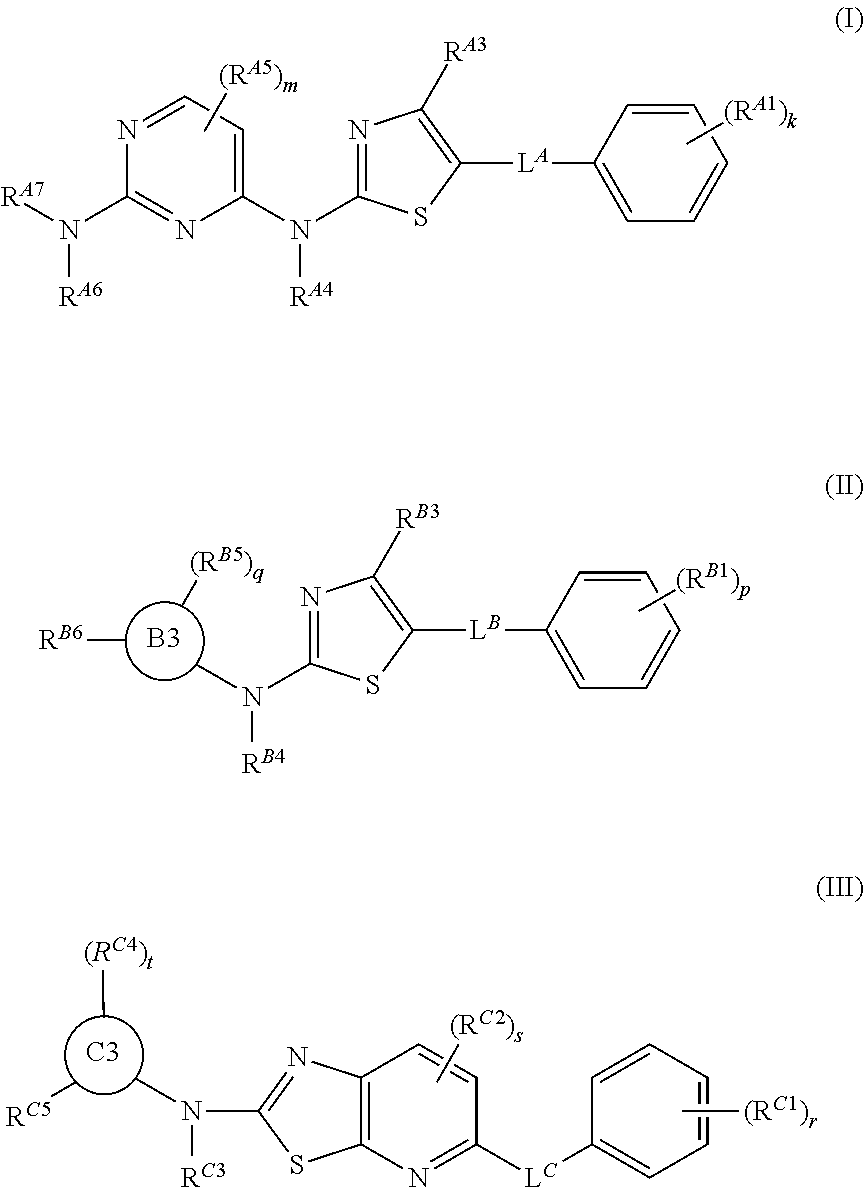Thiazolyl-containing compounds for treating proliferative diseases
a technology of proliferative diseases and thiazolyl, which is applied in the field of thiazolylcontaining compounds for treating proliferative diseases, can solve the problems of underlying immunodeficiency and a significant risk factor, and achieve the effects of reducing or avoiding symptoms, signs or causes of the condition, and reducing or minimizing one or more symptoms
- Summary
- Abstract
- Description
- Claims
- Application Information
AI Technical Summary
Benefits of technology
Problems solved by technology
Method used
Image
Examples
example 1
on of (S)-2-((2-((1-acryloylpyrrolidin-3-yl)amino)pyrimidin-4-yl)amino)-N-(2,6-dimethylphenyl)thiazole-5-carboxamide
[0410]
Methyl 2-((2-chloropyrimidin-4-yl)amino)thiazole-5-carboxylate
[0411]
[0412]A solution of a mixture of 2-chloropyrimidin-4-amine (5.0 g, 38.5 mmol) and methyl 2-chlorothiazole-5-carboxylate (6.85 g, 38.5 mmol, 1 equivalent (eq)) in dry N,N-dimethylformamide (75 ml) was cooled to 0° C. and was treated portionwise over 5 min with sodium hydride (60% w / w in mineral oil, 3.1 g, 76.9 mmol, 2 eq). The reaction mixture was stirred at 0° C. for 1 h and warmed to ambient temperature for a further 1 h. The mixture was treated with saturated ammonium chloride, followed by saturated aqueous Na2CO3 solution to reach pH 9, and the resulting mixture was extracted with 1:1 mixture of dichloromethane and ethyl acetate. The organic extracts were combined, dried using a hydrophobic frit, and evaporated under reduced pressure. The residue was purified by chromatography on silica to af...
example 2
on of (S)—N-(2,6-dimethylphenyl)-2-((2-((1-propionylpyrrolidin-3-yl)amino)pyrimidin-4-yl)amino)thiazole-5-carboxamide
[0421]
[0422](S)—N-(2,6-dimethylphenyl)-2-((2-((1-propionylpyrrolidin-3-yl)amino)pyrimidin-4-yl)amino)thiazole-5-carboxamide was prepared from 2-((2-chloropyrimidin-4-yl)amino)-N-(2,6-dimethylphenyl)thiazole-5-carboxamide, tert-butyl (S)-3-aminopyrrolidine-1-carboxylate and propionyl chloride using general procedures I and II. LCMS RT: 2.28 (Method A), Mass m / z: 466.62 (M+1). 1H NMR (400 MHz,) δ 12.47 (s, 1H), 9.77 (s, 1H), 8.53 (s, 1H), 8.38-8.28 (m, 1H), 8.08 (dd, J=6.4, 3.1 Hz, 1H), 7.13 (d, J=1.8 Hz, 3H), 6.44 (t, J=5.5 Hz, 1H), 4.51 (d, J=98.4 Hz, 1H), 3.97-2.94 (m, 3H), 2.28-2.21 (m, 1H), 2.19 (d, J=2.0 Hz, 6H), 2.08 (t, J=7.5 Hz, 1H), 1.97 (d, J=8.8 Hz, 1H), 1.01-0.91 (m, 3H), 0.91-0.78 (m, 2H).
example 3
on of (R)-2-((2-((1-acryloylpyrrolidin-3-yl)amino)pyrimidin-4-yl)amino)-N-(2, 6-dimethylphenyl)thiazole-5-carboxamide
[0423]
[0424](R)-2-((2-((1-acryloylpyrrolidin-3-yl)amino)pyrimidin-4-yl)amino)-N-(2,6-dimethylphenyl)thiazole-5-carboxamide was prepared from 2-((2-chloropyrimidin-4-yl)amino)-N— (2,6-dimethylphenyl)thiazole-5-carboxamide and tert-butyl (R)-3-aminopyrrolidine-1-carboxylate using general procedures I and II. LCMS RT: 2.23 (Method A), Mass m / z: 464.54 (M+1). 1H NMR (400 MHz,) δ 12.47 (s, 1H), 9.77 (s, 1H), 8.46 (s, 1H), 8.33 (d, J=5.3 Hz, 1H), 8.08 (d, J=6.6 Hz, 1H), 7.12 (s, 3H), 6.66-6.40 (m, 2H), 6.12 (ddd, J=17.3, 5.8, 2.5 Hz, 1H), 5.71-5.59 (m, 1H), 4.57 (d, J=69.4 Hz, 1H), 4.04-2.75 (m, 3H), 2.19 (s, 6H), 2.35-1.93 (m, 1H), 1.33-0.66 (m, 2H).
PUM
 Login to View More
Login to View More Abstract
Description
Claims
Application Information
 Login to View More
Login to View More - R&D
- Intellectual Property
- Life Sciences
- Materials
- Tech Scout
- Unparalleled Data Quality
- Higher Quality Content
- 60% Fewer Hallucinations
Browse by: Latest US Patents, China's latest patents, Technical Efficacy Thesaurus, Application Domain, Technology Topic, Popular Technical Reports.
© 2025 PatSnap. All rights reserved.Legal|Privacy policy|Modern Slavery Act Transparency Statement|Sitemap|About US| Contact US: help@patsnap.com



